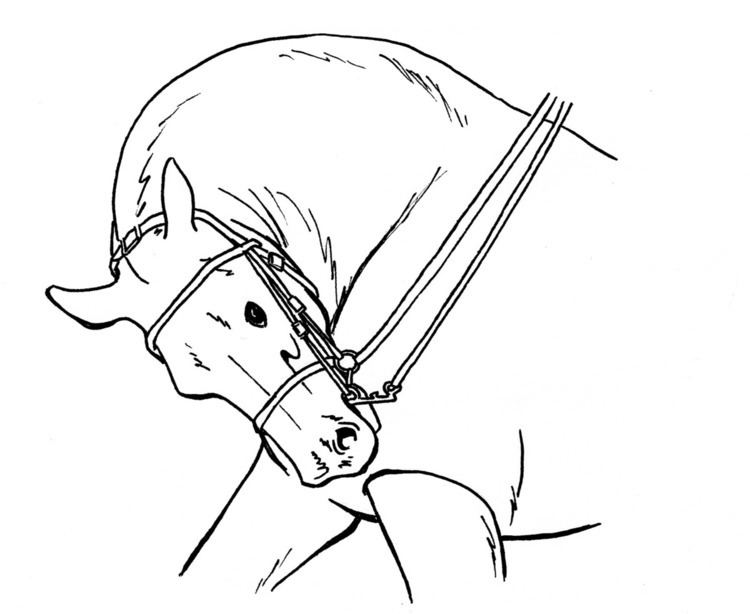 | ||
Rollkur or hyperflexion of the horse's neck is a practice in equestrianism defined as "flexion of the horse's neck achieved through aggressive force" and is banned by the world governing body, the International Federation for Equestrian Sports (FEI). The FEI recognises a distinction between rollkur and the riding of the horse in a deep outline not achieved by force.
Contents
The technique has been controversial for some time in equestrian circles, including the set up of specific petitions and boycotts (including a threatened boycott of the London 2012 Olympics) to promote banning of the practice. Despite the controversy, the technique has been used by dressage and show jumping riders. The FEI moved to ban the practice following the release of video of Swedish dressage rider Patrik Kittel using rollkur during warm up at a competition in Denmark where the horse's tongue appeared to turn blue as a result of the manoeuvre.
Usage
Most usage of the technique in recent times has been by dressage riders but rollkur was, and is still, used in other equestrian disciplines, most notably show jumping, before being adopted by some well-known dressage riders. However, it is not an old theory in dressage, either: Francois Baucher trained a similar method, although he did all his severe flexing at the halt, and in addition he connected the posture of the hind legs to the mix.
In dressage training, the rider can choose to make the horse work for periods with its neck lowered and its head behind the vertical, for various beneficial reasons, such as suppling, relaxing, and stretching the horse, yet rollkur takes this flexion to the extreme. In rollkur, the horse is asked to lower his head and round its neck as it works—working "deep"--so that the head is coming inward. In the extreme, the horse's mouth touches the middle of his chest. Rollkur is not a quick movement lasting a few seconds, but is held for a length of time, through work at the walk, trot, and canter, including shortening and extension of the gaits. Rollkur is not just longitudinal flexion (nose to chest or forelegs), but accompanied with repeated bending to the rider's leg.
Some riders who use rollkur accomplish the head position by lowering and fixing the hands until the horse yields its jaw backwards in response to the pressure on the bit. This technique (pulling in) goes against all classical riding. In classical dressage, the horse accepts the bit and the horse decides to come down with its head because it trusts the hands of the rider. In good companionship, it is possible to ask the horse to go a little deeper than the animal would do itself, but to obtain the extreme posture of rollkur does require physical coercion.
In western pleasure and related events, the same practice has been used for decades, though not called rollkur. Usually draw reins are used to achieve hyperflexion and a very low "headset" that is desired in competition.
Proponents
Riders who practice rollkur advocate it as a valuable training method to improve the suppleness of the horse, and point out that rules (prior to the introduction of the FEI ban) did not allow prolonged or extensive use of rollkur.
Proponents point to leading riders who apply this technique and have consistent winning scores in the arena as proof that the technique works. They further suggest that the process of working deep is meant to stretch and supple the back.
Arguments for banning
Those who disagree with rollkur say it goes against the principles of classical dressage and the written rules of the FEI. This includes the fact that the horse is physically behind the vertical. This makes it difficult to check if the horse is correctly accepting the bit. During hyperflexion of the neck the cervical vertebrae are compressed, where classical dressage promotes lengthening and relaxation of the neck. With rollkur, impulsion and throughness may be lost due to a stiff, improperly stretched back. This can easily occur when the hand of the rider is not gently asking the horse to come low (but pulling in) - and/ or the horse is not accepting the hand, but bending in an attempt to evade the hand. A pure disadvantage is that the horse is encouraged to bring its point of gravity towards the forehand.
There is also a great debate as to whether rollkur constitutes animal abuse, both physically due to the held over-flexed position, and mentally due to forced submission. Given that a similar practice is longstanding and routinely seen with the use of draw reins in schooling horses for events such as western pleasure, where it is close to being a universal practice (though also controversial in some circles), the debate has major ramifications across different disciplines.
